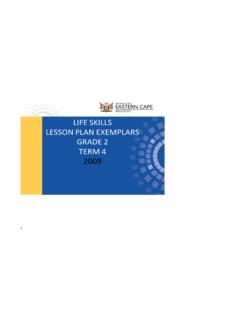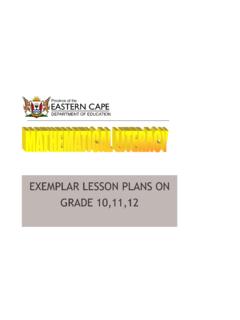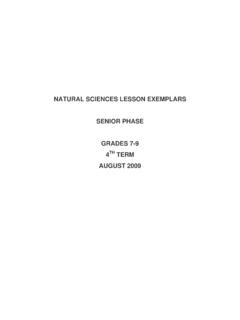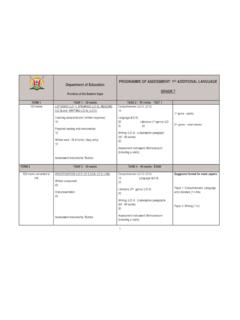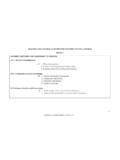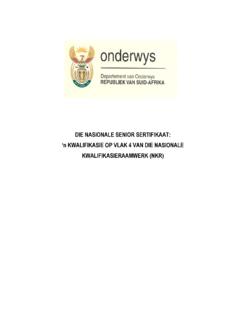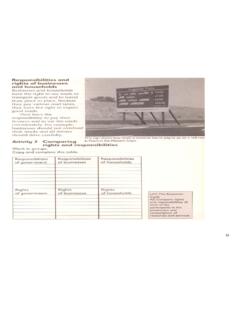Transcription of MATHEMATICAL LITERACY LESSON PLANS.
1 MATHEMATICAL LITERACY LESSON PLANS. GRADE 10. LESSON PLAN 1. Subject: MATHEMATICAL LITERACY Grade 10. LESSON Plan: Number and operations in context. Number f Activities : 3. Duration : +/- 9H00 Week 1 2 Date: . Context : Mathematics in everyday life. Link with previous LESSON : Number systems, number patterns, basic operation with numbers. CORE CONTENT: (KSV. KNOWLEDGE (K): Operations with different number systems. SKILLS (S):Estimating and calculating ratios, percentage and interests. Managing personal finance. VALUES: (V) Appreciating the understanding of ratios, percentages, fractions. ACTIVITY 1 ACTIVITY 2 ACTIVITY 3. Activity Content LO,s and AS's Detail of Activity Teacher introduces and explains the Learners work in groups with given Teacher demonstrates the conversion of number system and different number worksheets to discuss and perform fractions into percentage and vice versa.)
2 Patterns natural numbers, integers, basic operations with positive and - Compare fractions, decimals and whole numbers, real numbers. negative numbers, common fractions percentages. Simple fractions, compound and decimal and decimals and rounding off. - Learners work on percentage increase or fractions. decrease of given quantities. Learners perform basic operations with different numbers. Teaching Methods Explanation, question-answer Group work Demonstration, individual work Assessment Strategy :Form Class work, Home work. Class work, home work, short test. Class work, home work. : Tool Memos Memos. Memos. : Method Peer, individual. Peer, Teacher. Peer, individual. Expanded Opportunities: More challenging tasks on operations with larger and compound numbers.
3 Resources Calculator, work sheet. Work sheet, calculator. Work sheet, calculator. Teacher reflection LESSON PLAN 2. Subject: MATHEMATICAL LITERACY Grade 10. LESSON Plan: Number and operations in context Number f Activities : 3. Duration : +/- 9H00 Week 3 4 Date: . Context : Mathematics in everyday life, Personal finance management. Link with previous LESSON : Number systems, number patterns, basic operation with numbers. CORE CONTENT: (KSV). KNOWLEDGE (K): Income and expenditure, interest rates, Introduction to business practices. SKILLS (S):Estimating and calculating ratios, percentage and interests. Managing personal finance. VALUES: (V) Appreciating the understanding of representing numbers in different ways, accruing the ability to solve problems individually.
4 ACTIVITY 1 ACTIVITY 2 ACTIVITY 3. Activity Content Ratio and proportion Scientific notation Simple and compound growth LO,s and AS's ; ; Detail of Activity Teacher explains the meaning of ratio and Teacher introduces the concept of Teacher introduces simple and compound proportion with relevant examples. exponents and the use of scientific growth of investments.(includes using the Learners investigates and do calculations notation.(including the use of scientific formula for compound interest. based on ratio and proportion including calculator). Provides learners with pay slips, fractional and decimal numbers. Learners are given a worksheet to do a municipal statements, budget samples, etc. variety of exercises on representing for learners to work with.)
5 Both large and small numbers using Learners work in groups to solve problems exponents and scientific notation. based on the above. Teaching Methods Explanation, investigation. Group work Group work Assessment Strategy :Form Class work, Home work. Class work, home work, short test. Class work, home work, Assignment. : Tool Memos Memos. Memos, rubric. : Method Peer, individual. Peer, Teacher. Peer, individual, teacher. Expanded Opportunities: More challenging tasks based on above operations from study guides. Resources Calculator, work sheet, text Work sheet, calculator, text book. Text book, bills and statements. Teacher reflection LESSON PLAN 3. Subject: MATHEMATICAL LITERACY Grade 10. LESSON Plan: Space, shape and measurement.
6 Number f Activities : 3. Duration : +/- 9 hH00 Week: 5 6 Date: . Context : Everyday life contexts. Link with previous LESSON : Geometric figures, operation with numbers. CORE CONTENT: (KSV). KNOWLEDGE (K): Measuring lengths and calculating perimeter and areas. SKILLS (S): Measuring skills, calculating, estimating, conversion of units. VALUES: (V) Understanding and appreciating the ability to measure accurately. ACTIVITY 1 ACTIVITY 2 ACTIVITY 3. Activity Content Area and volume Scale drawing of plans Scale drawing of maps. LO,s and AS's ; ; Detail of Activity Teacher organizes meter rules, tape Teacher provides learners with plans of Learners are provided with maps of measure, strings, etc for learners to houses and maps and explains how to Eastern cape and South Africa and they measure accurately lengths & convert given scales to actual distances and work either individually or in groups to heights of geometrical figures in lengths.
7 Answer questions . their classroom (eg. Tables, desks, Learners to do measurements of lengths, Learners to do measurements of lengths, chalk board, cupboard, boxes, etc.) distances and directions on maps and do distances and directions on maps and do and calculate their perimeter, area conversions to SI units. conversions to SI units. and volume of right prisms and Learners work in groups to calculate Learners work in groups to calculate express their answers in different distance, speed and time taken to travel distance, speed and time taken to travel units. between two points. between two points. Teaching Methods Group work Group work Group work Assessment Strategy :Form Class work, Home work. Class work, home work, class test.
8 Class work, Controlled Test. : Tool Memo. Memos. Memo. : Method Peer, individual. Peer, teacher. Teacher. Expanded Opportunities: More challenging tasks on geometrical figures and solids as well as maps and plans. Resources Measuring instruments Maps of towns and countries , house plans. Maps and plans. Teacher reflection LESSON PLAN 4. Subject: MATHEMATICAL LITERACY Grade 10. LESSON Plan: Space, shape and measurement. Number f Activities : 3. Duration : +/- 9H00 Week : 7 8 Date: . Context : Geometrical solids, reading and interpreting maps and plans. Link with previous LESSON : Measurement of lengths, areas and volumes. CORE CONTENT: (KSV). KNOWLEDGE (K): Measuring and calculating surface area and volume of geometric solids.
9 SKILLS (S): Measuring, estimating, converting units VALUES: (V) Appreciating the knowledge and understanding of measuring and calculating areas and volumes. ACTIVITY 1 ACTIVITY 2 ACTIVITY 3. Activity Content Conversion of units. Surface areas and volumes Scale drawing LO,s and AS's ; Detail of Activity Teacher revises the meaning of areas Learners are given at least 4 different Teacher reinforces the concept of maps of both regular and irregular solids. geometrical solids ( cube, cuboid, cone, and scale drawing of house plans. Derives the formulae for calculating pyramid, cylinder) and they work in groups Learners are given the task to draw areas and volumes clearly showing to measure and determine the surface area plans and interpret when given actual transformation 1D 2D 3D.
10 And volume of given solids and express measurements of house plans. Learners given exercises to calculate their answers in SI units as well as in the areas and volumes and to convert and daily used units. Additional exercises with water tanks, express answers in different units. swimming pool, classroom, sports field. Teaching Methods Discovery, question& answer Group work Group and individual work Assessment Strategy :Form Class work, home work, Group work, home work, short test. Assignment, class work. : Tool Memos Memo, check list. Memo : Method Peer, individual. Teacher, peer. Teacher, peer Expanded Opportunities: Measuring surface areas and volumes of solids around at home and in the community. Resources Regular and irregular object.
